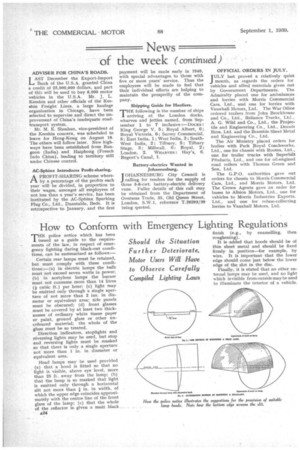How to Conform with Emergency Lighting Regulations
Page 26

If you've noticed an error in this article please click here to report it so we can fix it.
T"police notice which has been issued as a guide to the requirements Of the law, in respect of emergency lighting during black-out conditions, can be summarized as follows:—
Certain rear lamps must be retained, but must comply with these conditions:—(a) in electric lamps the bulb must not exceed seven watts in power; (b) in acetylene lamps the burner must not consume more than 14 litres (i cubic ft.) per hour; (c) light may be emitted only through a single aperture of not more than 2 ins, in diameter or equivalent area; side panels must be obscured; (d) front glasses most be covered by at least two thicknesses of ordinary white tissue paper or paint, ground glass or other uncoloured material; the whole of the glass must be so treated. Direction indicators, stoplights and reversing lights may be used, but stop and reversing lights must be masked so that there is only a single aperture not more than 1 'in. in diameter or equivalent area.
Head lamps may be used provided (a) that a hood is fitted so that no light is visible, above eye level, more than 25 ft. away from the lamp; (b) that the lamp is so masked that light is emitted only through a horizontal slit not more than I in. in width, of which the upper edge coincides approximately with the centre line of the front glass of the lamp; (c) that the whole of the reflector is given a matt black A24 finish (e.g., by enamelling, then roughening) .
It is added that hoods should be of thin sheet metal and should be fixed firmly in position—for example, by wire. It is important that the lower edge should come just below the lower edge of the slot in the disc.
Finally, it is stated that no other external lamps may be used, and no light which is visible from outside may be used to illuminate the interior of a vehicle.




































































